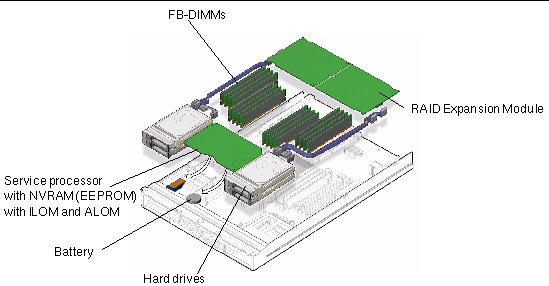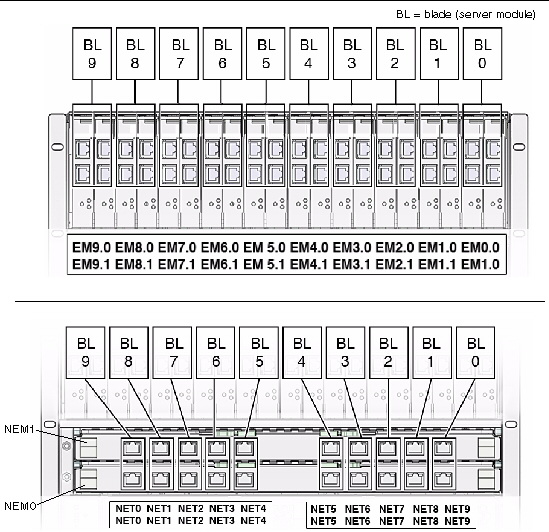| C H A P T E R 1 |
|
Sun Blade T6320 Server Module Product Description |
This chapter provides an overview of the features of the Sun Blade T6320 server module. (A server module is also known as a “blade.”)
The following topics are covered:
FIGURE 1-1, FIGURE 1-2 and FIGURE 1-3 show the main Sun Blade T6320 components and some basic connections to the chassis. For information about connectivity to system fans, PCI ExpressModules, Ethernet modules, and other components, see the chassis documentation at:
http://docs.sun.com/app/docs/prod/blade.t6320
FIGURE 1-1 Sun Blade T6320 Server Module With Chassis

TABLE 1-1 lists the Sun Blade T6320 server module features. TABLE 1-2 lists some of chassis input-output features.
FIGURE 1-2 Front and Rear Panels
| Note - For information about connecting to the server module refer to the Sun Blade T6320 Server Module Installation Guide, 820-2384. |
FIGURE 1-3 Cable Dongle Connectors
Insert the connector straight into the server module.
| Note - If you are using the older 4-cable dongle (UCP-4), do not use the RJ-45 connector with the Sun Blade T6320 server module. Use the DB-9 connector for serial connections. |
|
One UltraSPARC T2 multicore processor with 4MB L2 cache. Can execute up to 64 threads. |
|
|
Up to four hot-pluggable 2.5-inch hard drives. (Filler panels are inserted anywhere hard drives are not installed.) |
|
|
RAID expansion modules (hard drive management) with RAID 0, 1 controller. Eight links, x2 SAS (3 Gb/s) or SATA (1.5 Gb/s), supporting four internal hard drives and four x2 links to midplane. See Section 1.2, Support for RAID Storage Configurations. |
|
|
One universal connector port (UCP) in the front panel. A universal cable is included with the chassis and can be purchased separately (FIGURE 1-3). The following connections are supported:
|
|
|
SPARC V9 architecture, ECC protected Platform name: SUNW, Sun Blade T6320 Server Module Minimum system firmware 7.0.6 or subsequent compatible release |
|
|
Two 10 Gb ethernet ports. Consult the chassis documentation or Network Express Module (NEM) documentation for ethernet pass-through specifications. (See FIGURE 1-5 and FIGURE A-2.) |
|
|
Two 8-lane ports connect to chassis midplane. Can support up to two 8-lane PCI ExpressModules (PCI EM). (FIGURE 1-5) |
|
|
Four channels for remote storage connect from the RAID Express Module (REM) to the chassis midplane. |
|
|
ILOM management controller on the service processor. CLI management (ssh only) and N1 system manager support. DMTF CLI and ALOM-CMT compatible CLI available through ssh. Remote console (remote KVMS) is configurable through OpenBoot PROM and ILOM. |
|
|
ILOM management controller on the service processor. CLI management (telnet, ssh) and N1 system manager support. ALOM CMT shell within the ILOM controller. |
|
For more information about chassis features and controls, refer to the service manual for your blade chassis at:
http://docs.sun.com/app/docs/prod/blade.srvr
FIGURE 1-4 Field-Replaceable Units

|
FRU Name[1] |
|||
|---|---|---|---|
|
Controls the host power and monitors host system events (power and environmental). Socketed EEPROM stores system configuration, all Ethernet MAC addresses, and the host ID. |
|||
|
Section 4.5, Removing and Replacing the Battery on the Service Processor |
|||
|
RAID expansion modules (Hard drive management for up to 12 hard drives) |
Section 4.6, Replacing or Installing the Sun Blade RAID 5 Expansion Module Section 4.6, Replacing or Installing the Sun Blade RAID 5 Expansion Module |
||
FIGURE 1-5 PCI Express and Ethernet Connections on a Sun Blade 6000 Modular System

The UltraSPARC T2 multicore processor is the basis of the Sun Blade T6320 server module. The processor has four, six, or eight UltraSPARC cores. Each core equates to a 64-bit execution pipeline capable of running eight threads. The result is that the 8-core processor handles up to 64 active threads concurrently. For more information about the UltraSPARC T2 multicore processor, go to:
http://www.sun.com/processors/UltraSPARC-T2/features.xml
http://www.sun.com/servers/wp.jsp?tab=1
In addition to software RAID configurations, you can set up hardware RAID 1 (mirroring) and hardware RAID 0 (striping) configurations for any pair of internal hard drives using the on-board controller, providing a high-performance solution for hard drive mirroring.
By attaching one or more external storage devices (such as the Sun Blade 6000 Disk Module) to the Sun Blade T6320 server module, you can use a RAID to configure system drive storage in a variety of different RAID levels.
As shipped, the internal hard drives are not configured for RAID. To make a disk part of a RAID array while preserving the data on the drive, add the drive to a mirrored RAID set (also known as hardware RAID Level 1).
Before configuring RAID, you must configure a RAID expansion module (REM).The Sun Blade T6340 Server Module supports two REMs, the Sun Blade RAID 5 and Sun Blade RAID 0/1 G2 Expansion Modules.
Refer to the following for RAID configuration instructions:
| Note - The Sun Blade 6000 Disk Module is an external storage blade that provides eight additional drives for configuring RAID and is supported for both REMs. |
The Sun Blade RAID 5 Expansion Module supports RAID levels 0, 1, 1E, 10, 5, or 6 with global or dedicated hot spares. When a Sun Blade RAID 5 Expansion Module is installed, SAS drives can be installed in disk slots 0 through 3. You can configure these disks as RAID 0, 1, 5, or 10.
For information on creating a bootable array, see Appendix B. For information on installing the OS on a bootable array, see Appendix C.
The Sun Blade RAID 0/1 G2 Expansion Module supports RAID 1 (two mirrored disks with an optional hot spare) or RAID 1E (three or more mirrored disks with one or two hot spares).
To obtain support for your system, you need the serial number. The serial number is located on a sticker on the front of the server module (FIGURE 1-6).
FIGURE 1-6 Serial Number and MAC Address Location

You can type the ILOM show /SYS command or the ALOM CMT showplatform command to obtain the chassis serial number. Both examples are shown below.
sc> showplatform SUNW, Sun Blade T6320 Server Module Blade Serial Number: 1005LCB-07385N005L Chassis Serial Number: 1005LCB-0709YM007M Slot Number: 5 Domain Status ------ ------ S0 Running sc> |
Documentation for the Sun Blade T6320 server module, and related hardware and software is listed in Product Documentation.
The following resources are also available.
Copyright © 2010, Oracle and/or its affiliates. All rights reserved.